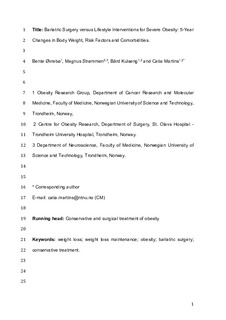Bariatric surgery versus lifestyle interventions for severe obesity: 5-year changes in body weight, risk factors and comorbidities
| dc.contributor.author | Øvrebø, Bente | |
| dc.contributor.author | Strømmen, Magnus | |
| dc.contributor.author | Kulseng, Bård Eirik | |
| dc.contributor.author | Martins, Catia | |
| dc.date.accessioned | 2018-02-23T13:28:58Z | |
| dc.date.available | 2018-02-23T13:28:58Z | |
| dc.date.created | 2017-03-30T19:03:40Z | |
| dc.date.issued | 2017 | |
| dc.identifier.citation | Clinical Obesity. 2017, 7 (3), 183-190. | nb_NO |
| dc.identifier.issn | 1758-8111 | |
| dc.identifier.uri | http://hdl.handle.net/11250/2486786 | |
| dc.description.abstract | Changes in body weight (BW), risk factors and comorbidities 5 years after Roux-en-Y gastric bypass (RYGB) or different lifestyle interventions are compared. A total of 209 (75% women) severe obese adults were non-randomly allocated to: (A) RYGB (n = 58), (B) weight loss (WL) camp (n = 30), (C) residential intermittent programme (n = 64) or (D) hospital outpatient programme (n = 57). Body weight, risk factors and comorbidities were assessed at baseline, 1 and 5 years. A total of 89 and 54% completed the 1- and 5-year follow-up. The RYGB group experienced more WL at 5 years (−23.9%, 95% CI [−27.7, −20.0]) compared with lifestyle groups: (B) (−9.2%, 95% CI [−16.9, −1.5]), (C) (−4.1%, 95% CI [−8.0, −0.1]) and (D) (−4.1 kg, 95% CI [−10.0, 1.8]) (all P < 0.001). No differences were observed between lifestyle groups, although groups B and C had significant WL after 5 years (all P < 0.05). Plasma glucose and high-density lipoprotein cholesterol were improved in the RYGB group at 5 years compared with lifestyle groups (all P < 0.05). More patients in the RYGB group experienced remission of hypertension (P < 0.05). RYGB was associated with a lower BW, improved blood parameters and hypertension remission compared with lifestyle interventions at 5 years. However, significant WL was also achieved with lifestyle interventions. | nb_NO |
| dc.language.iso | eng | nb_NO |
| dc.publisher | Wiley | nb_NO |
| dc.title | Bariatric surgery versus lifestyle interventions for severe obesity: 5-year changes in body weight, risk factors and comorbidities | nb_NO |
| dc.type | Journal article | nb_NO |
| dc.type | Peer reviewed | nb_NO |
| dc.description.version | acceptedVersion | nb_NO |
| dc.source.pagenumber | 183-190 | nb_NO |
| dc.source.volume | 7 | nb_NO |
| dc.source.journal | Clinical Obesity | nb_NO |
| dc.source.issue | 3 | nb_NO |
| dc.identifier.doi | 10.1111/cob.12190 | |
| dc.identifier.cristin | 1462554 | |
| dc.description.localcode | © 2017 World Obesity Federation. This is the peer reviewed version of the article, locked until 20 March 2018 due to copyright restrictions. It has been published in final form at http://dx.doi.org/10.1111/cob.12190. This article may be used for non-commercial purposes in accordance with Wiley Terms and Conditions for Self-Archiving. | nb_NO |
| cristin.unitcode | 194,65,15,0 | |
| cristin.unitcode | 194,65,30,0 | |
| cristin.unitname | Institutt for klinisk og molekylær medisin | |
| cristin.unitname | Institutt for nevromedisin og bevegelsesvitenskap | |
| cristin.ispublished | true | |
| cristin.fulltext | original | |
| cristin.qualitycode | 1 |
